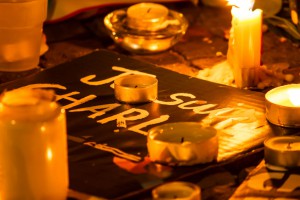Film Review: Je Suis Charlie Depicts Harrowing Account of Charlie Hebdo Attacks

Charb. Cabu. Tignous. Wolinski. These and other courageous defenders of free expression appear by name as part of the dedication in the opening minute of Je Suis Charlie, the Netflix documentary released on the one-year anniversary of the terrorist attacks on the headquarters of French satirical newspaper Charlie Hebdo. The film’s narrator, in one of many humanistic statements made in the film, reveals the purpose of the documentary: “We want to share the words of these free men because we miss them, and because it feels good … and to fight back against their murderers’ words of hate with drawings, words, and joy of life.”
The film replays the events that took place from the day of the attack, January 7, 2015, through the publication of the first post-attack issue of Charlie Hebdo the following week. Surviving members of the Charlie Hebdo staff—cartoonists, managing editors, lawyers—smile and laugh when describing their colleagues—publisher Stéphane “Charb” Charbonnier and cartoonist Jean “Cabu” Cabut in particular—whom they considered personal friends. But their faces immediately change when they recount the events that transpired that January 7. Fighting back tears, cartoonist Corrine “Coco” Rey describes how she encountered the terrorists outside the office and, with a gun at her back, was taken hostage and led to the Charlie Hebdo newsroom, where the terrorists specifically targeted Charb due to his drawings of Mohammed and his vocal criticism of fundamentalist Islam.
Hope is returned upon seeing footage of the three million people on the streets of Paris, carrying the now iconic black and white “Je suis Charlie” signs. Yet criticisms against Charlie Hebdo were unforgiving in the days following, largely driven by French religious leaders who believed “they were asking for it.” The anger and frustration seething from cartoonist Laurent “Riss” Sourisseau is visible as he recounts the number of victim-blaming articles that were published, one written by a former Charlie Hebdo employee. Finance director Eric Portheault also can’t help expressing irritation at the French media for not having defended Charlie Hebdo’s earlier Mohammed drawings: “They’re here now. Where were they before?”
There’s limited video footage of the deceased cartoonists’ own words, most of which appear in interviews that took place in 2007 after organized Islamic groups sued the paper for its drawings of Mohammed. The film also does very little to describe the founding of Charlie Hebdo as a satirical French publication and even less about the cartoonists’ personal lives or early lives before working for the newspaper.
The film’s most valuable insights come from video coverage of the Libération newsroom days after the attacks, where remaining Charlie Hebdo staff temporarily took office and began working to produce another issue. The cover of issue number 1178, published on January 14, 2015, depicts Mohammed carrying a sign that reads Tout est pardonne, “All is forgiven.” (A copy of this issue proudly hangs in the American Humanist Association’s office in Washington, DC.)
Watching Je Suis Charlie hit close to home. The mission of the American Humanist Association is not unlike the goals of Charlie Hebdo—we advocate for free expression and freedom of belief, criticize extremist ideology, and promote secularism—though we’re highly unlikely to experience a similar attack. But after the ISIL attacks in Paris last November that took 129 lives and the murder of fourteen people by a radicalized Muslim couple in San Bernardino last December, a global effort to prevent further tragedies committed by religious extremists must take place.
One thing is for sure: the brave cartoonists at Charlie Hebdo did not lose their lives in vain. Terrorists can kill, but freedom of expression will never die.
Special thanks to TheHumanist.com writer Kevin Dolgin for providing a copy of Charlie Hebdo issue number 1178 to the American Humanist Association.
